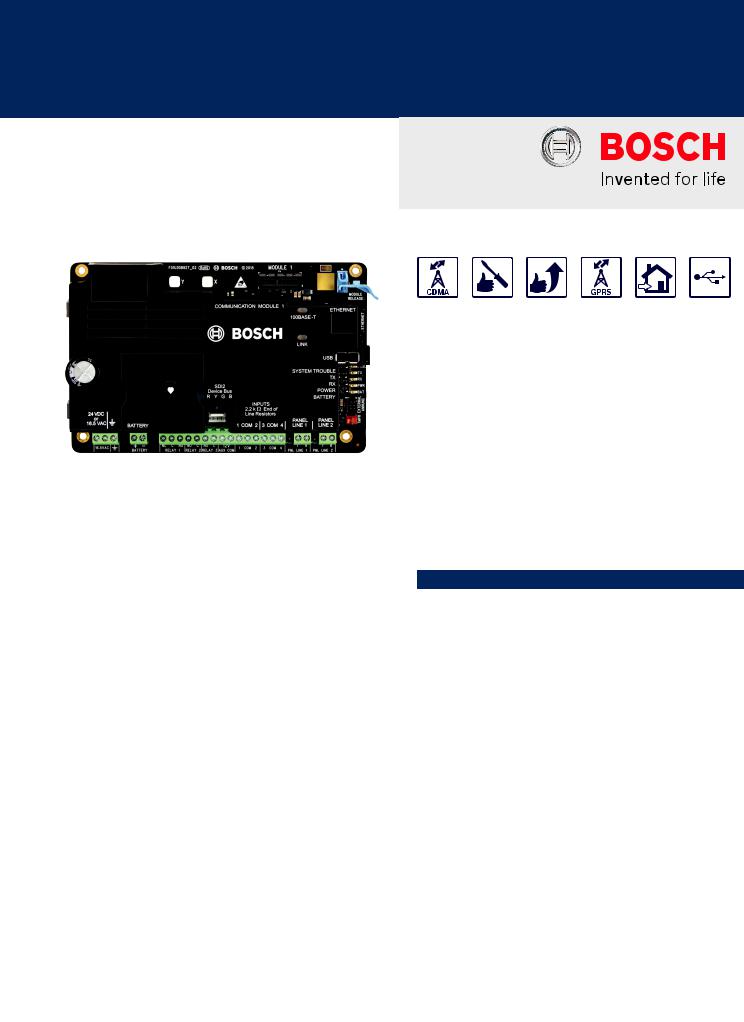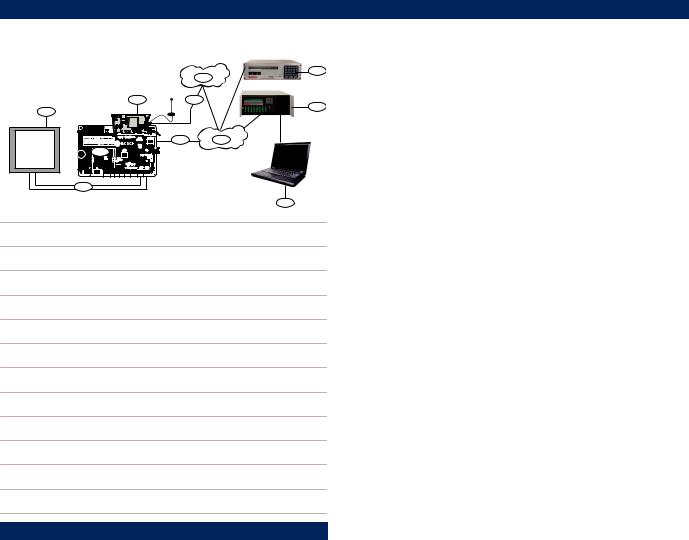Bosch B465-MR-120WI, B465-MR-1640, B465-MRC-120WI, B465-MRC-1640, B465-MW-1640 Specsheet
...
Intrusion Alarm Systems | B465 Universal Dual Path Communicator
B465 Universal Dual Path Communicator
www.boschsecurity.com
The B465 Conettix Universal Dual Path Communicator converts the Public Switch Telephone Network (PSTN) digital dialer, or dry contact outputs from an intrusion/ fire control panel to an IP signal for transmission over the Ethernet or cellular network. The B465 Conettix Universal Dual Path Communicator is UL 864 10th Edition approved per NFPA 72 version 2013.
The module can use its built-in Ethernet connection, and/or an optional Conettix plug-in cellular module (B440/B441/B442/B443) to send reports to the central station receiver.
Automation programming for the supported control panel remains unchanged with the installation of the B465 module, thus simplifying the installation process This allows for a smooth transition from the PSTN realm into IP. All messages generated internally by the B465 are shown in Contact ID format at the central station.
The module can be powered from a 16.5 VAC transformer or 24 VDC power supply.
uCompatible with any control panel using Contact ID, SIA, Pulse 3/1 or Pulse 4/2 communication formats (auto detecting)
uNo control panel reprogramming required to install
uSupports Ethernet directly and optional plug-in cellular communication technologies in single, or multi-path configurations
uSupports four configurable inputs and three configurable outputs
uApproved for Commercial Fire/Burglary applications as sole, primary, or secondary communication path
System overview
The B465 simulates dial tone and line voltages when the digital dialer has a report to send. The module simulates a PSTN connection to the central station. The module decodes the control panel’s PSTN dialer report and sends the decoded reports by IP connection using Bosch’s Conettix Protocol to the Conettix D6600, D6100IPv6, or D6100i Communication Gateway/Receiver (referred to as the receiver). When the receiver acknowledges receipt of the message, it sends an acknowledgement report to the module which in turn sends an acknowledgement to the connected control panel. This process maintains true end-to-end security.

2 | B465 Universal Dual Path Communicator
|
9 |
|
8 |
4 |
7 |
|
10 |
1 |
|
5 |
6 |
3 |
|
2 |
|
|
11 |
Callout Description
1 Intrusion/fire control panel
2 Control panel phone line connections
3 B465 Conettix Universal Dual Path Communicator
4 B44x plug-in cellular communicator
5 Ethernet connection (LAN/WAN)
6 Internet
7 Cellular communication to cellular carrier
8 Cellular carrier network
9 Conettix receiver/gateway
10 Conettix receiver/gateway
11 Monitoring center automation
Functions
PSTN inputs (2)
When the control panel’s PSTN dialer sends a message, the module simulates a PSTN connection to the central station. The module connects to the host control panel through either one or both of the Phone Line inputs. Both Panel Line 1 and Panel Line 2 of the module run 28 VDC and support Contact ID (4 and 10 digit account codes), Pulse 3/1, Pulse 4/2, and SIA communication formats. The B465 is setup to auto detect the communication format which eliminates programming steps.
IP Communication options
The module uses the on-board Ethernet connector, and/or optional B440 Conettix Plug-in Communicator, Cellular (3G), B441 Conettix Plug-in CDMA Cellular Communicator, B442 Conettix Plug-in GPRS Cellular Communicator, or B443 Conettix Plug-in HSPA+ Cellular Communicator to communicate with a Conettix D6600, Conettix D6100i or a Conettix D6100IPv6 Communications Receiver/Gateway. Using Conettix IP communication protocol offers a secure path that includes anti-replay/anti-substitution features and provides enhanced security with up to AES 256-bit encryption.
The module supports Domain Name System (DNS) for central station communication. DNS provides ease of use, eliminating the need to use static IP addresses as your reporting destination, and accommodates a simple solution for central station disaster recovery.
Direct wire inputs
The B465 provides four on-board inputs. Each input functions independently and does not interfere with the operation of the others. The module monitors the input loops for normal, shorted, or open conditions between an input terminal and any of the input common terminals. Inputs are disabled by default so no EOL resistors are required until activated.
These four inputs on the B465 connect to dry contact outputs on the control panel and generate Contact ID reports instead of using a phone line connection/or in addition to using the control panel phone connection. The available functions are:
•Panel System Trouble
•Panel AC Fail
•Panel Battery Trouble
•Fire Alarm
•Fire Trouble
•Burg Alarm
•Burg Trouble
•Fire Supervisory
Each input allows the use of dry contacts or powered outputs up to 30 VDC if needed. The inputs use 2.2K EOLs to monitor the dry contact outputs when connected to dry contacts. The inputs recognize the following thresholds when using dry contacts: 2.0 to 3.0 VDC = Normal, 3.7 to 5.0 VDC = Open, 0.0 to 1.3 VDC = Short.
Outputs
Includes three programmable output relays rated at 30 VDC, 0.1 A. These outputs can be used to show the status of the B465 or they can be connected to the control panel zone inputs for reporting B465 system faults. The three outputs consist of RELAY 1, RELAY 2, and RELAY 3.
•RELAY 1 is active (energized) once the B465 is running. If the B465 detect a problem or loses power, RELAY 1 de-energizes, which can be used to indicate a system trouble on the local control panel's zone inputs, if required. Depending on the configuration required to create a system trouble on the control panel, the installer needs to use either the NO and COM or the NC and COM connections. Refer to the control panel manual for the required zone configuration to obtain the proper input response.
•RELAY 2 is a normally open (NO) relay with contacts that close when the desired function programmed is detected.
•RELAY 3 is a normally open (NO) relay with contacts that close when the desired function programmed is detected.
